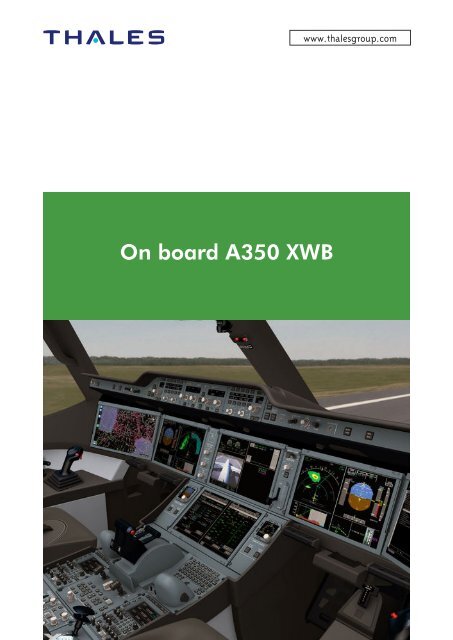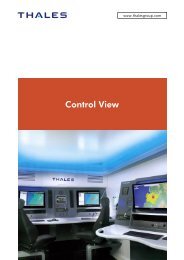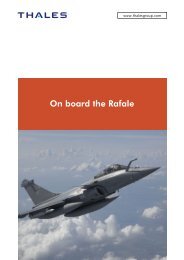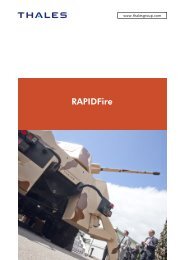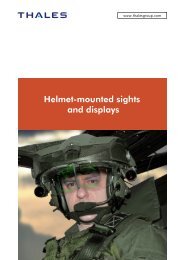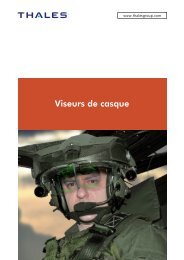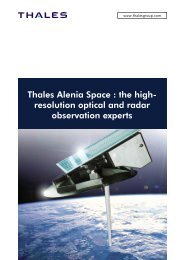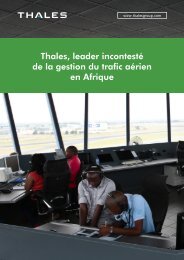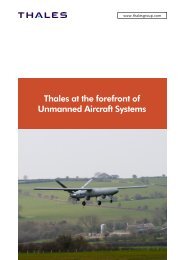On board A350 XWB - Thales Group
On board A350 XWB - Thales Group
On board A350 XWB - Thales Group
You also want an ePaper? Increase the reach of your titles
YUMPU automatically turns print PDFs into web optimized ePapers that Google loves.
<strong>On</strong> <strong>board</strong> <strong>A350</strong> <strong>XWB</strong><br />
www.thalesgroup.com
Main events<br />
January 2008 : <strong>Thales</strong> is selected by Airbus on a large avionics shipset and for electrical power conversion.<br />
End 2009 : <strong>Thales</strong> starts to deliver the first IMA elements to Airbus and partners in charge of developing software<br />
functions.<br />
April 2010 : <strong>Thales</strong> IFE is selected for the cabin.<br />
2012 :<br />
• February: <strong>A350</strong> <strong>XWB</strong> engine flies for the 1st time on A380 flying test bed; <strong>Thales</strong> is on<strong>board</strong> with few equipments<br />
including the ADIRU.<br />
• August 2nd: Cockpit power-on.<br />
• 2nd half 2012: <strong>Thales</strong> delivers pieces of equipment ready for first flight.<br />
Since 2009 up to May 2013 : 1529 pieces of equipment delivered to Airbus.<br />
June 2013 : <strong>A350</strong> <strong>XWB</strong> first flight.<br />
<strong>Thales</strong>, an Airbus strong partner on<strong>board</strong> <strong>A350</strong> <strong>XWB</strong><br />
Relation between Airbus and <strong>Thales</strong> reaches a new step with the new <strong>A350</strong> <strong>XWB</strong> program. <strong>Thales</strong> is selected in 2008<br />
to design and deliver avionics solutions for this new long range aircraft: interactive control and display system, integrated<br />
modular avionics (IMA), air data and inertial reference unit, as well as electrical power conversion.<br />
Besides, <strong>Thales</strong> contributes to doors and slides management system and Slats and Flaps control computer developed<br />
and delivered to Airbus by Diehl Aerospace.<br />
<strong>On</strong> top of that, <strong>Thales</strong> is selected for the cabin with IFE and connectivity systems.<br />
This program is managed in Toulouse for avionics perimeter and involves all other French <strong>Thales</strong> Avionics entities: Meudon,<br />
Châtellerault, Bordeaux/Le Haillan, Vendôme and Valence, with hundreds of people dedicated to this program.<br />
<strong>Thales</strong> technologies on<strong>board</strong><br />
2
<strong>Thales</strong> technologies on <strong>board</strong><br />
Displays and interactivity<br />
With the advent of the A380 and now the <strong>A350</strong> <strong>XWB</strong>, the<br />
main change in the cockpit has been the shift to large<br />
display screens. <strong>Thales</strong> fits A380 cockpits with ten main<br />
screens, eight of which deal with avionics-related information,<br />
the remaining two being <strong>On</strong>-<strong>board</strong> Information System<br />
(OIS) displays, covering outside and open information<br />
relating to weather, traffic, etc.<br />
The <strong>A350</strong> <strong>XWB</strong> will feature fewer but larger display systems<br />
than the A380. <strong>Thales</strong> will be supplying six 15in (38cm)<br />
rectangular screens and the Key<strong>board</strong> Cursor Control Unit<br />
(KCCU) which is one of the interface with Flight Management<br />
System. The cockpit configuration has two central<br />
displays mounted, one above the other and a single display<br />
in front of each pilot with an on-<strong>board</strong> information<br />
system screen adjacent to it. There are no differences in the<br />
functionalities between these lateral and central displays<br />
as, unlike the A380 configuration, all the displays can be<br />
used for both types of information.<br />
The <strong>A350</strong> <strong>XWB</strong> features an integrated system bringing together<br />
so-called “open world” and “closed world” (secure<br />
avionics) information, enabling the optimized management<br />
of information to allow the pilots to work efficiently<br />
together. For instance, they can bring information from the<br />
lateral screens to the central ones to allow them to work<br />
together on a particular piece of information. The advantage<br />
of having common screens means that the pilot can<br />
use the KCCU to interface with the OIS.<br />
With the new <strong>A350</strong> <strong>XWB</strong>, if one of the screens fails, the cockpit<br />
displays are automatically reconfigured to use the lateral<br />
displays. The fact that all six screens can be used for all information<br />
within the cockpit is an important factor for airlines, as<br />
it will help to maintain high aircraft dispatch availability levels.<br />
The new cockpit display system achieves simplified and<br />
streamlined interactivity with the entire system.<br />
Overall, the <strong>A350</strong> <strong>XWB</strong> cockpit has been designed as a<br />
natural evolution of the A380 cockpit, with the aim of ensuring<br />
continuity throughout the range. An A380 pilot will<br />
need just minimal amounts of training to be able to transfer<br />
to the new layout and functions of the <strong>A350</strong> <strong>XWB</strong>. This<br />
will result in a reduction in training costs and optimized use<br />
of airline resources.<br />
From the pilot’s standpoint, the large cockpit screens will<br />
enable optimized information management and improved<br />
situational awareness. Furthermore, the large screens<br />
have future-proof product evolution characteristics and<br />
provide the potential in the future for new types of displays<br />
for future generations of Airbus aircraft.<br />
Integrated Modular Avionics (IMA)<br />
<strong>Thales</strong>’s Integrated Modular Avionics (IMA) solution represents<br />
a real-time airborne computer network system.<br />
This network consists of a number of computing modules<br />
capable of supporting numerous applications of differing<br />
criticality levels. The IMA is a major technical evolution of<br />
global importance for airlines and operators.<br />
Using new technologies, <strong>Thales</strong> has standardised and<br />
reduced by half the number of CPIOMs (Core Processing<br />
Inputs/Outputs Module) and CRDCs (Common Remote<br />
Data Concentrator) – both of which are the main<br />
building blocks of the IMA suite – meaning that the components<br />
are easier to maintain, repair and stock.<br />
Also, the number of functions hosted by the CPIOM<br />
has been increased from 21 (A380) to 35 (<strong>A350</strong> <strong>XWB</strong>).<br />
For instance, the “doors and slides” function that was<br />
previously handled by a specific computer is now managed<br />
by the standard CPIOM. <strong>On</strong> top of that, the calculation<br />
capacity of the CPIOM has been doubled, its<br />
reliability increased and weight reduced.<br />
The IMA represents a substantial leap along the path to<br />
standardization and simplification, and the whole aircraft<br />
is set to benefits.<br />
Navigation System<br />
<strong>Thales</strong> has also implemented a new navigation system.<br />
The ADIRU (Air Data Inertial Reference Unit) defines<br />
the position of the plane with high precision and accuracy.<br />
Combined with a Flight Management System<br />
and OANS (<strong>On</strong><strong>board</strong> Airport Navigation System), it<br />
will enable pilots to have the highest-possible precision<br />
guidance tools at their disposal.<br />
These technologies will enable the airlines to use SESAR<br />
new procedures (example: 4D trajectories) as soon as<br />
they will be available.<br />
Head-up Display (HUD)<br />
<strong>Thales</strong>’ HUD already available on all aircraft within the<br />
Airbus Fly-By-Wire family. A single or dual configuration<br />
will be available as a customer option in the <strong>A350</strong><br />
<strong>XWB</strong> catalogue.<br />
New HUD provides a flexible platform for growth to<br />
support new features such as Enhanced Vision Systems<br />
(EVS) and potentially Surface Guidance System (SGS)<br />
and Synthetic Vision Systems (SVS), in addition to offering<br />
unique symbology entirely consistent with Airbus’<br />
cockpit philosophy.<br />
Press Contact<br />
<strong>Thales</strong>, Media Relations - Civil Aerospace<br />
Giaime Porcu<br />
Tel: +33 6 88 23 84 79<br />
giaime.porcu@thalesgroup.com<br />
3


